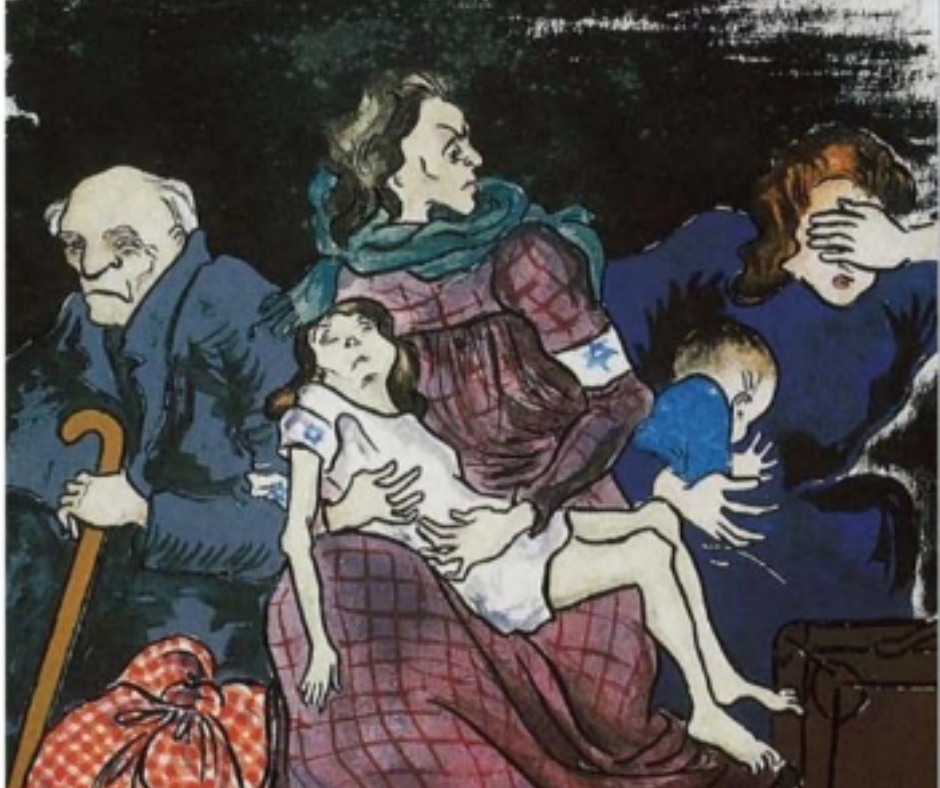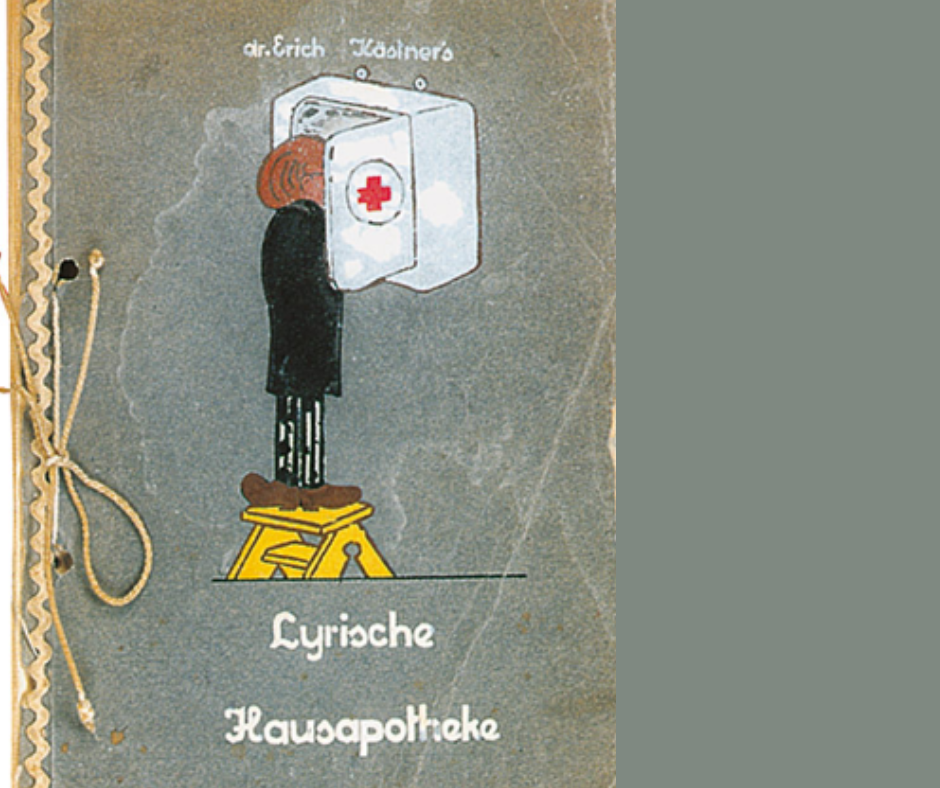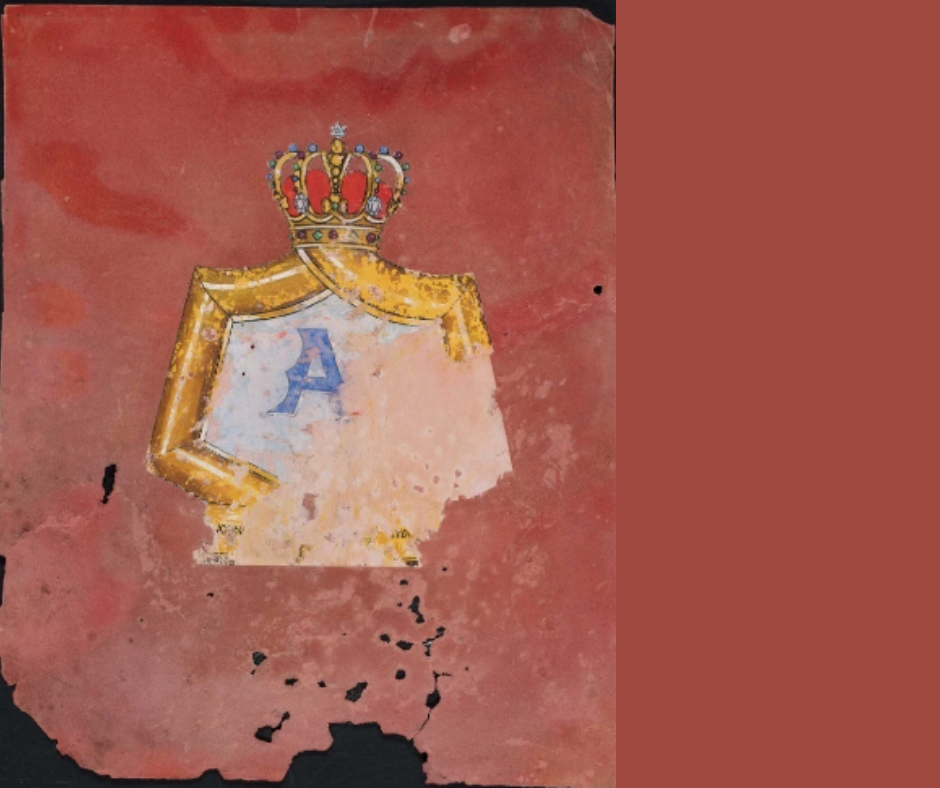by Caroline Slifkin
Teofila Langnas was born in 1920 in Łódź, Poland into a Jewish merchant family, her mother: Emilia Langnas, 1886-1942 and her father Fajwel (Pawel) Langnas , 1885_1940 who was a textile dealer and co-owner of the cloth factory Langnas, Goldblum and Zajackowski. (One of her drawings, ‘Moving into the ghetto’: depicts checked scarves like the one the woman is wearing which were woven by her father Pawel Langnas' factory.)
Tosia was accepted for studying art at an Ecole des Beaux ´ Arts, Paris, to start on 1st September 1939. The outbreak of war makes this impossible. Instead, she moves with parents to Warsaw with her parents. Her father who had been dispossessed by the National Socialists, committed suicide on January 21, 1940, whereupon Helene Reich asked her son Marcel (Reich-Ranicki) to look after Teofila.
From that day the two became a couple. They married in July 1942 in the Warsaw Ghetto where the couple lived from 1940 to 1943. Marcel Reich worked there as a translator, which meant that he and his wife were temporarily spared from deportation to the Treblinka extermination camp. Studying art in the Warsaw Ghetto, despite all the horrors. As well as she could, Tosia continued her art studies. Paints had to be stolen from the German authorities – a capital offense. At the request of the Judenrat, Teofila made numerous watercolours for the ghetto commissioner Heinz Auerswald for an illustrated book about the first days of one's life Babies because Auerswald's wife was expecting a child.
This was intended to secure the release of Jewish children, which was achieved only two days before the deportation. However, she also secretly portrayed everyday life and death in the ghetto. She was able to have these watercolours smuggled out and hidden before she fled the ghetto. Marcel and Tosia escape from Ghetto. 1943-1944 hidden by Polish family near Warsaw. 7th September 1944. Liberation by Red Army. 1948-1949 they are in London: Marcel is a Polish diplomat. 30th December 1948 their son Andrew born in London. 1949- 1958 Warsaw: Marcel writes about German literature.1958.
Move from Poland to Germany. 1959-1973 Hamburg. She kept her Warsaw ghetto drawings under wraps for over 50 years until the Jewish Museum Frankfurt developed them into an exhibition in 1999, which she later published as a book volume. Her small format graphics bear witness to the horrors of Nazi rule, show fear and hunger terror and arbitrariness, and are documents of the collapse of the world and values. The late recognition gave Tosia some satisfaction, but she never recovered form her wartime experiences. She did not draw again after the war. 2Oth April 2011. Tosia dies in Frankfurt.
https://www.maths.ed.ac.uk/~v1ranick/surgery/bio.htm
https://www.maths.ed.ac.uk/~v1ranick/surgery/tosia.pdf
https://www.maths.ed.ac.uk/~v1ranick/ghetto.pdf

WAITING FOR THE TRANSPORTATION
Date: 1942 Warsaw ghetto
Materials: Watercolours
Collection: digitized in Andrew Ranicki, ‘My Mother Teofila Reich-Ranikci’ (presentation, Edinburgh German Circle, Edinburgh, UK, February 28, 2012.
Size: I have not been able to find measurements yet of the artwork.
Description of the artwork:
In Teofila’s, ‘Waiting for the transport to Treblinka’, Teofila depicts a group of people of varying ages who have been through a selection in the Warsaw ghetto and have been selected for deportation to Treblinka Death Camp. The group are sat waiting for the transport. We see all the people except the central girl/young woman in a short white dress/hospital gown are wearing what look like warm clothes and the elderly man a thick coat. We see they are wearing a white armband with a blue Star of David. We see they have their personal objects either in a suitcase or in a bundle of woven fabric. We see their body language which depicts their emotions and interactions. The colour palette is dark and sombre.
Connection of the artwork to the historical background of the ghetto:
In the artwork we can see people wearing the mandatory white and blue Star of David armband, as was the ruling in Poland.
The artwork depicts people after having gone through a selection in the Warsaw ghetto waiting for the transport to Treblinka. Teofila went through selection in the Warsaw ghetto and said,” We’re standing here somewhere. We hold each other's hands. This is the farm on Zamenhof Street, and this is our selection. There, the SS man will soon point the whip -to the left to death, to the right: to life.” Teofila experienced, witnessed, and painted these scenes of selections and awaiting transport. On 23 July 1942 the first major deportation of 7,400 Jews from the Warsaw ghetto arrived at Treblinka. The daily quota was set at 6,000 people, grew rapidly according to documents of the Jewish Council. Teofila’s husband Marcel learned of the deportation first hand as he was called into Adam Czerniaków’s office to type up the direct orders for the deportation as Herman Hofle dictated them to the remaining members of the Jewish Council.
Questions to ask:
In the Warsaw Ghetto, Teofila Langnas was given a copy of Erich Kästner's "Lyrical Medicine Chest" that had been brought there. She made a calligraphic transcription of it and decorated it with coloured vignettes. She gave this copy to Marcel Reich-Ranicki, her friend and later husband, for his 21st birthday in 1941. She had sometimes hoped for "mental tutoring from Erich Kästner" Have I ever received a more beautiful gift? I'm not sure. But I've never received one that was made with more effort - and more love. So, there we sat together, Tosia and I, and slowly and thoughtfully we read the German verses that she had copied out for me in the dark of night and in the poor lighting. From a nearby ghetto entrance, we occasionally heard German gunshots and Jewish screams. We flinched, we trembled. But that night we read on - the "Lyrical Medicine Chest". And we, who had not known love for long, were delighted by the somewhat wistful, but nevertheless wonderful "Factual Romance". So, we read about the two who had suddenly lost love "like other people lose a stick or a hat" and who simply couldn't believe it. We thought about our future together, which we were convinced could not exist - unless, perhaps, in a concentration camp.
Marcel Reich-Ranicki_My Life

The collection of the Jewish Historical Institute includes an album of drawings, tentatively titled "Satirical Album on the Activities of the Jewish Council" (hereinafter referred to as the Satirical Album). The description published in ARG states that "The album [was] listed in the list of archival materials of "Oneg Shabbat" from 06-07.1942. Doc. was re-included in the Archives in 2012”. The 29 drawings preserved in the Satirical Album concern as many departments, offices and departments in the structure of the Judenrat of the Warsaw Ghetto - from the Chairman of the Jewish Council in Warsaw, the Board of the Council and the General Secretariat, to the Jewish Social Welfare Society (the order of individual cards was determined by default). A number of cards are significantly damaged, but this does not prevent most of the text from being read.
So far, it was assumed that the satirical album was made by an anonymous employee of the Jewish Council. There is no doubt, however, that it’s yet unidentified author is Teofila Langnas, later known under the name Reich-Ranicka, creator of a series of drawings and watercolours depicting scenes from the Warsaw Ghetto, wife of the later famous literary critic, Marcel Reich-Ranicki. This unique document has not received much attention so far. However, it is not only a testimony, but also a rare, satirical portrayal of the time of the Holocaust, part of a larger and more widely known series of works by Reich-Ranicka. The information describing the Satirical Album lists all the units and offices that are presented in the convention of black humour. Cards made of coloured paper, tempera and watercolor were used, in two cases collage. The 32 cards have the same dimensions: 260x215 mm, the paper and, to some extent, the pictures were damaged as a result of being hidden in the ruins of the ghetto.
The cover bears the inscription "Der Obmann des Judenrates in Warschau. Verwaltung des Judischen Wohnbezirk in Warschau. Chairman of the Jewish Council in Warsaw. Management Board of the Jewish Council in Warsaw. The composition with a coat of arms in a golden frame, topped with a crown with a Star of David, is certainly attributed to the chairman of the Judenrat, Adam Czerniakow. On the purple field of the shield there is a monogram consisting of two letters, of which only the first "A" has been preserved, painted in blue paint. So we have the first part of Adam Czerniakow's initial, calligraphed in a shade of blue ( techelet ) chosen for the Jews by God - and at the same time an ironic, "coat of arms" form. At the same time, it is a biblical symbolization of the President of the Council in the role of a Jewish king (regardless of whether the crown on it refers to the Torah or to King David).
If there was a separate card with graphics dedicated to the entire Board of the Jewish Council, it has not survived.

SOURCE
Milena Jesenska & Margarete Buber-Neumann